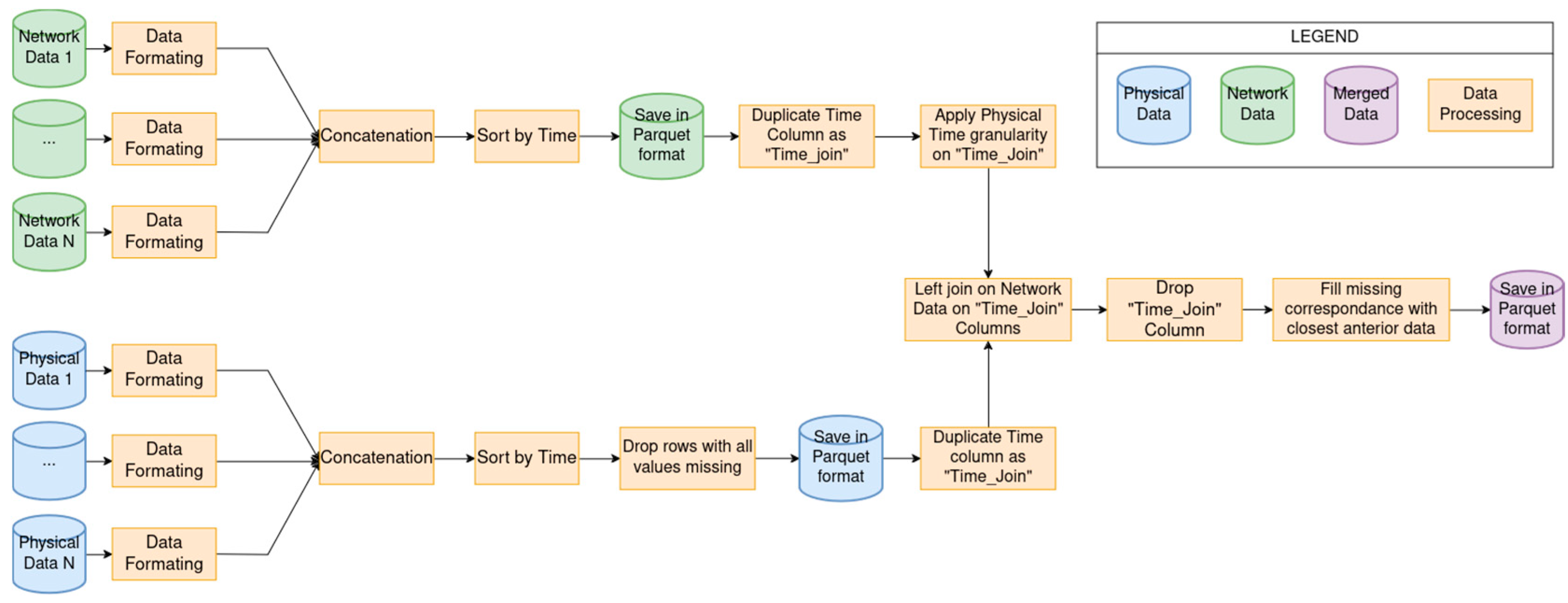Combining Physical and Network Data for Attack Detection in Water Distribution Networks †
Abstract
1. Introduction
2. Materials and Methods
2.1. Data Combination Process
2.2. Experimental Setup
3. Results
4. Discussion and Conclusions
Author Contributions
Funding
Institutional Review Board Statement
Informed Consent Statement
Data Availability Statement
Conflicts of Interest
References
- Tuptuk, N.; Hazell, P.; Watson, J.; Hailes, S. A Systematic Review of the State of Cyber-Security in Water Systems. Water 2021, 13, 81. [Google Scholar] [CrossRef]
- Ahmed Jamal, A.; Mustafa Majid, A.-A.; Konev, A.; Kosachenko, T.; Shelupanov, A. A Review on Security Analysis of Cyber Physical Systems Using Machine Learning. Mater. Today Proc. 2023, 80, 2302–2306. [Google Scholar] [CrossRef]
- Faramondi, L.; Flammini, F.; Guarino, S.; Setola, R. A Hybrid Behavior- and Bayesian Network-Based Framework for Cyber–Physical Anomaly Detection. Comput. Electr. Eng. 2023, 112, 108988. [Google Scholar] [CrossRef]
- Faramondi, L.; Flammini, F.; Guarino, S.; Setola, R. A Hardware-in-the-Loop Water Distribution Testbed Dataset for Cyber-Physical Security Testing. IEEE Access 2021, 9, 122385–122396. [Google Scholar] [CrossRef]
- Deb, S.; Claudio, D. Alarm Fatigue and Its Influence on Staff Performance. IIE Trans. Healthc. Syst. Eng. 2015, 5, 183–196. [Google Scholar] [CrossRef]


| Data | Model | TPR Normal | TPR DoS | TPR MITM | TPR Physical Fault | TPR Scan |
|---|---|---|---|---|---|---|
| Physical | XGB | 99.21% | 96.88% | 88.56% | 95.48% | 0.00% |
| Network | XGB | 99.90% | 97.50% | 1.41% | 0.01% | 100.00% |
| Network + Graph | XGB | 98.04% | 99.51% | 88.69% | 77.43% | 87.50% |
| Combined | XGB | 99.91% | 99.94% | 99.74% | 99.62% | 100.00% |
| Combined + Graph | XGB | 99.96% | 99.96% | 99.77% | 99.67% | 91.30% |
| Data | Model | FPR DoS | FPR MITM | FPR Physical Fault | FPR Scan |
|---|---|---|---|---|---|
| Physical | XGB | 0.031% | 0.505% | 0.164% | 0.000% |
| Network | XGB | 0.066% | 0.043% | 0.000% | 0.000% |
| Network + Graph | XGB | 0.011% | 0.755% | 0.984% | 0.000% |
| Combined | XGB | 0.003% | 0.036% | 0.036% | 0.000% |
| Combined + Graph | XGB | 0.002% | 0.016% | 0.020% | 0.000% |
Disclaimer/Publisher’s Note: The statements, opinions and data contained in all publications are solely those of the individual author(s) and contributor(s) and not of MDPI and/or the editor(s). MDPI and/or the editor(s) disclaim responsibility for any injury to people or property resulting from any ideas, methods, instructions or products referred to in the content. |
© 2024 by the authors. Licensee MDPI, Basel, Switzerland. This article is an open access article distributed under the terms and conditions of the Creative Commons Attribution (CC BY) license (https://creativecommons.org/licenses/by/4.0/).
Share and Cite
Frappé - - Vialatoux, C.; Parrend, P. Combining Physical and Network Data for Attack Detection in Water Distribution Networks. Eng. Proc. 2024, 69, 118. https://doi.org/10.3390/engproc2024069118
Frappé - - Vialatoux C, Parrend P. Combining Physical and Network Data for Attack Detection in Water Distribution Networks. Engineering Proceedings. 2024; 69(1):118. https://doi.org/10.3390/engproc2024069118
Chicago/Turabian StyleFrappé - - Vialatoux, Côme, and Pierre Parrend. 2024. "Combining Physical and Network Data for Attack Detection in Water Distribution Networks" Engineering Proceedings 69, no. 1: 118. https://doi.org/10.3390/engproc2024069118
APA StyleFrappé - - Vialatoux, C., & Parrend, P. (2024). Combining Physical and Network Data for Attack Detection in Water Distribution Networks. Engineering Proceedings, 69(1), 118. https://doi.org/10.3390/engproc2024069118






